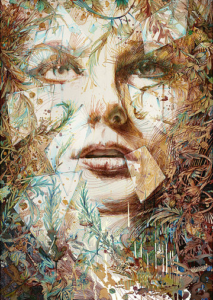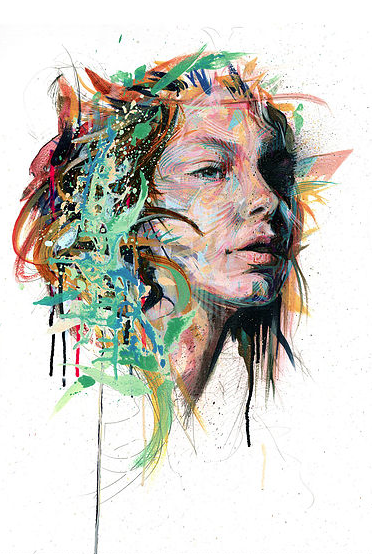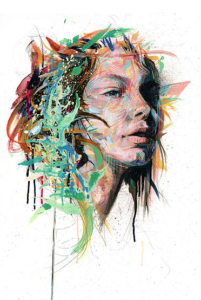Featured Artist: Carne Griffiths
Carne Griffiths is an amazing abstract portrait artist who creates spell-binding work. I was thrilled when he agreed to answer some questions for an artist feature for my blog. Check out his work at www.carengriffiths.com and connect on social media at : FACEBOOK – INSTAGRAM – TWIT
1. Tell us about your journey as an artist.
I grew up always fascinated by drawing the real world and creating the imaginary, I always considered drawing a solace and something I returned to throughout my childhood. I was unable to study art at school, as we returned to this country from New Zealand and there were no places. so I picked back up again at A Level, and went onto study a foundation course and then a degree in Illustration at Maidstone College of Art (KIAD) now part of UCA. after graduating I took a job as a draftsman at a hand embroidery firm in Soho London where I worked for 12 years and became the company’s Creative Director. After some time and it was a tough decision, I wanted to try and see what a year’s work of self led artwork would take me so I resigned from the embroidery firm and bega to paint for myself. I realised as soon as I started drawing that the influence of 12 years of embroidery design with a focus on nature was having a strong influence on the pieces I made so I began to allow this side of the work to evolve naturally.

2. You create the most interesting semi-abstract portraits and figurative work. Tell us a little about your process and how you discovered your unique style.
During my time at Art College I became fascinated with the connection between the unconscious mind, muscle memory and drawing. These led to a series of sketchbooks exploring simple mark making and meditation. When I returned to portraiture these elements were embedded like a kind of language in my drawing so I was able to float in quite a lucid way between the figurative and abstract in my work. There is always an internal dialogue when I am drawing, but there are moments when I try to bloack any critical thinking and allow impulse to take over. It is this interplay between different states of mind and meditation that create the style I work in and mean that the pieces I create are in a constant state of change.
3. I understand you often incorporate mixed media and liquids, such as liquor, tea, etc. into your work. How important is experimentation in your studio?
Experimentation and chaos are very important aspects of my work, I relate what I do to elements in nature, I love repitition and rhythm also but without the influence of chaos the work would become boring to me, so I try to take risks with each piece of work, especially when you think you have created or are creating something special – that is the most dangerous moment, that is when it is best to take the greatest risks, because you break outside of what is your normal routine. If I create a strong piece I can return to it and look at the work as though it were created by someone else, for me that’s a really important thing – to be able to disconnect the conscious mind from what is being created during the process. The liquids for me are used throughout the process and they redefine the work, they can change things dramatically sometimes for the worse, but they allow the chaos into the work, Sometimes it is a small amount of liquid thrown with energy across the piece – sometimes a full kettle of boiling water over the work, but it is always done in the moment and without consideration.
4. Which artists have influenced you most and why?
I have been influenced in my approach to art by a number of outsider artists. I think the biggest influences and game changers in respect to what I do are not stylistic influences but influences in approach and authenticity to painting. I enjoy reading manifestos from painters and approaches to process. There is a lot said about outsider artists versus trained and schooled artists but really the terms are misleading. The outsider artist is a driven creative thinker, with no formal training… however this does not mean a formal artist with training cannot approach their work in the same way as an outsider. I don’t really believe creativity can be taught and many outsider artists are celebrated for their creativity and original thinking and passion, over their academic technique. This creativity for me is the magic of art and it can be brought to the work by any artist. The most important thing is individuality, and personal vision. Henry Darger is a huge influence in this respect, as are the findings of Leonardo Da Vinci and his creative thinking and problem solving, really there is little that separates the vision of these two great artists except the acceptance of their vision, and even knowing what we know now does not diminish the greatness of Da Vincis methods of discovery. Other artists who created wonderful worlds through their own personal vision that really struck a chord with my work are, Jan Svankmajer, The Brothers Quay, Adolf Wolfli and Alphonse Mucha for his unique graphical style and pure draftsmanship.
5. What five things can you not live without when you are painting?
When I am painting the five most important things are
Music
My favourite turquoise and sepia inks
tea
alcohol
natural light

6. What advice do you have for artists who are just starting out and those who are established?
My advice for other painters is try to be fearless, look forward, paint from experience, and combine your passions to create. be aware of what other artists are creating and be selective about what you gather from others work, focus on what makes you unique and be honest with your painting.


